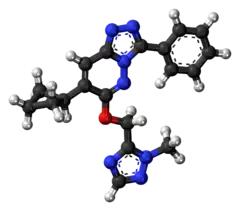TP-13
 | |
 | |
| Identifiers | |
|---|---|
IUPAC name
| |
| CAS Number | |
| PubChem CID | |
| ChemSpider | |
| UNII | |
| Chemical and physical data | |
| Formula | C19H19N7O |
| Molar mass | 361.409 g·mol−1 |
| 3D model (JSmol) | |
SMILES
| |
InChI
| |
| (verify) | |
TP-13 is an anxiolytic drug with a novel chemical structure, which is used in scientific research. It has similar effects to benzodiazepine drugs, but is structurally distinct and so is classed as a nonbenzodiazepine anxiolytic. It is a subtype-selective partial agonist at GABAA receptors, binding selectively to GABAA receptor complexes bearing α2 and α3 subunits.[1] It has modest anticonvulsant activity although less than that of diazepam,[2] and its main effect is likely to be selective anxiolytic action, as seen with other related α2/3-preferring agonists such as L-838,417.
References
- ↑ McCabe C, Shaw D, Atack JR, Street LJ, Wafford KA, Dawson GR, et al. (February 2004). "Subtype-selective GABAergic drugs facilitate extinction of mouse operant behaviour". Neuropharmacology. 46 (2): 171–8. doi:10.1016/j.neuropharm.2003.09.004. PMID 14680756. S2CID 38218522.
- ↑ Fradley RL, Guscott MR, Bull S, Hallett DJ, Goodacre SC, Wafford KA, et al. (June 2007). "Differential contribution of GABA(A) receptor subtypes to the anticonvulsant efficacy of benzodiazepine site ligands". Journal of Psychopharmacology. 21 (4): 384–91. doi:10.1177/0269881106067255. PMID 17092983. S2CID 34355306.
This article is issued from Offline. The text is licensed under Creative Commons - Attribution - Sharealike. Additional terms may apply for the media files.